2011 PEUGEOT 4007 ESP
[x] Cancel search: ESPPage 121 of 236
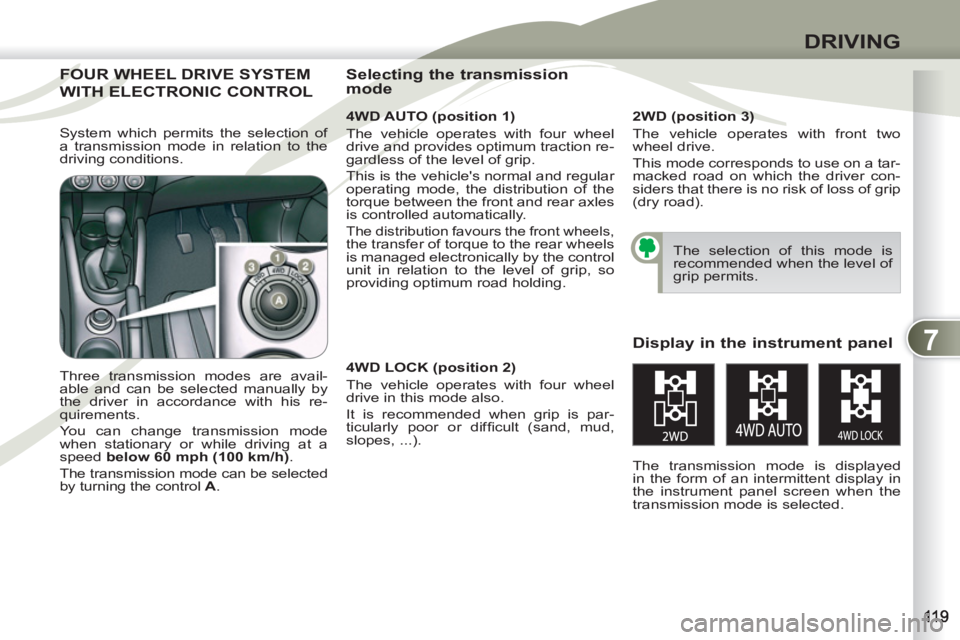
7
DRIVING
FOUR WHEEL DRIVE SYSTEMFOUR WH
WITH ELECTRONIC CONTROL WITH E
4WD AUTO (position 1)
The vehicle operates with four wheel
drive and provides optimum traction re-
gardless of the level of grip.
This is the vehicle's normal and regular
operating mode, the distribution of the
torque between the front and rear axles
is controlled automatically.
The distribution favours the front wheels, the transfer of torque to the rear wheels
is managed electronically by the control
unit in relation to the level of grip, so
providing optimum road holding.
Three transmission modes are avail-
able and can be selected manually by
the driver in accordance with his re-
quirements.
You can change transmission mode
when stationary or while driving at a
speed below 60 mph (100 km/h)
.
The transmission mode can be selected
by turning the control A
.
Display in the instrument panel
The transmission mode is displayed
in the form of an intermittent display in
the instrument panel screen when the
transmission mode is selected.
Selecting the transmission
mode
The selection of this mode is
recommended when the level of
grip permits.
2WD (position 3)
The vehicle operates with front two
wheel drive.
This mode corresponds to use on a tar-
macked road on which the driver con-
siders that there is no risk of loss of grip
(dry road).
4WD LOCK (position 2)
The vehicle operates with four wheel
drive in this mode also.
It is recommended when grip is par-
ticularly poor or diffi cult (sand, mud,
slopes, ...). System which permits the selection of
a transmission mode in relation to the
driving conditions.
Page 125 of 236

7
DRIVING
AUDIBLE REAR PARKINGAUDIBLE
SENSORS NSO
It detects obstacles (person, vehicle,
tree, gate, ...) located behind the vehi-
cle, but it cannot detect obstacles locat-
ed immediately below the bumper.
Activation
The parking sensors are activated by
engaging reverse gear.
The proximity information is indicated by
an audible signal which becomes more
frequent as the vehicle approaches the
obstacle.
When a certain distance between the
rear of the vehicle and the obstacle is
reached, the audible signal becomes
continuous:
An object such as a stake, a road
works cone or any other similar
object may be detected at the
beginning of the manoeuvre but
may no longer be detected when
the vehicle moves closer to it.
Location of the sensors
The vehicle is fi tted with four sensors:
- two side sensors A
- two central sensors B
.
Vehicle only
Vehicle fi tted with a towbar
Detection zones
The detection zones differ depending
on whether the vehicle is fi tted with a
towbar.
If you select towbar mode, the towbar
zone C
is excluded from the detection
zones.
The parking sensor system cannot,
in any circumstances, take the place
of the need for vigilance and respon-
sibility on the part of the driver.
Sensors
Distance between
vehicle and
obstacle less than:
Side A
Approximately
25 cm
Central B
without
towbar
Approximately
40 cm
Central B
with
towbar
Approximately
60 cm
System consisting of proximity sensors
installed in the rear bumper.
Page 131 of 236
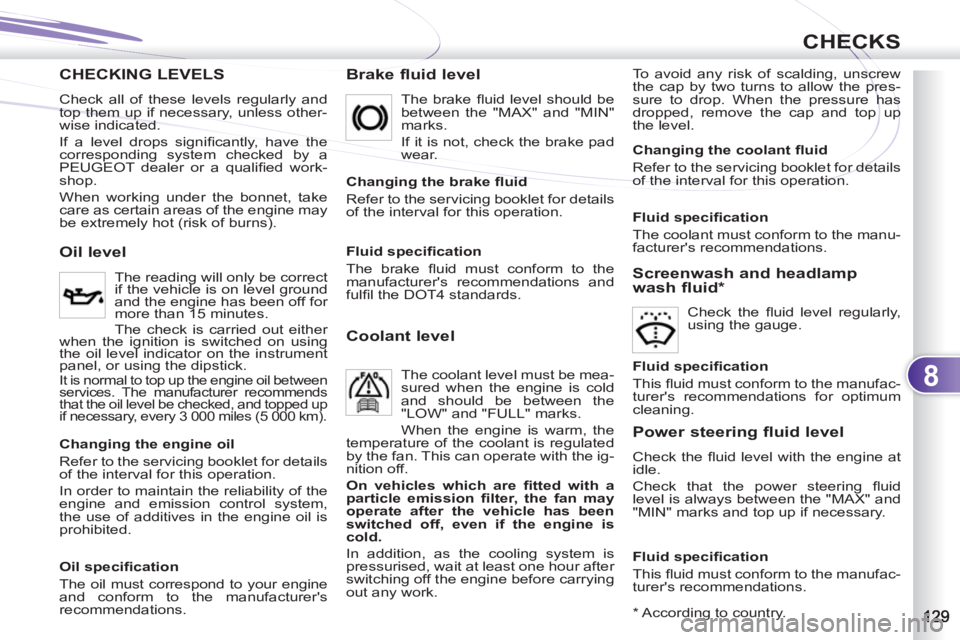
8
CHECKS
CHECKING LEVELS
Brake fluid level
To avoid any risk of scalding, unscrew
the cap by two turns to allow the pres-
sure to drop. When the pressure has
dropped, remove the cap and top up
the level.
Oil level
The reading will only be correct
if the vehicle is on level ground
and the engine has been off for
more than 15 minutes.
The check is carried out either
when the ignition is switched on using
the oil level indicator on the instrument
panel, or using the dipstick.
It is normal to top up the engine oil between
services. The manufacturer recommends
that the oil level be checked, and topped up
if necessary, every 3 000 miles (5 000 km).
The brake fl uid level should be
between the "MAX" and "MIN"
marks.
If it is not, check the brake pad
wear.
Changing the brake fl uid
Refer to the servicing booklet for details
of the interval for this operation.
Coolant level
The coolant level must be mea-
sured when the engine is cold
and should be between the
"LOW" and "FULL" marks.
When the engine is warm, the
temperature of the coolant is regulated
by the fan. This can operate with the ig-
nition off.
On vehicles which are fi tted with a
particle emission fi lter, the fan may
operate after the vehicle has been
switched off, even if the engine is
cold.
In addition, as the cooling system is
pressurised, wait at least one hour after
switching off the engine before carrying
out any work.
Screenwash and headlamp
wash
fluid*
Check the fl uid level regularly,
using the gauge.
*
According to country.
Changing the engine oil
Refer to the servicing booklet for details
of the interval for this operation.
In order to maintain the reliability of the
engine and emission control system,
the use of additives in the engine oil is
prohibited.
Oil specifi cation
The oil must correspond to your engine
and conform to the manufacturer's
recommendations.
Fluid specifi cation
The brake fl uid must conform to the
manufacturer's recommendations and
fulfi l the DOT4 standards.
Changing the coolant fl uid
Refer to the servicing booklet for details
of the interval for this operation.
Fluid specifi cation
The coolant must conform to the manu-
facturer's recommendations.
Fluid specifi cation
This fl uid must conform to the manufac-
turer's recommendations for optimum
cleaning.
Power steering fluid level
Check the fl uid level with the engine at
idle.
Check that the power steering fl uid
level is always between the "MAX" and
"MIN" marks and top up if necessary.
Fluid specifi cation
This fl uid must conform to the manufac-
turer's recommendations.
Check all of these levels regularly and
top them up if necessary, unless other-
wise indicated.
If a level drops signifi cantly, have the
corresponding system checked by a
PEUGEOT dealer or a qualifi ed work-
shop.
When working under the bonnet, take
care as certain areas of the engine may
be extremely hot (risk of burns).
Page 147 of 236

9
PRACTICAL INFORMATION
Dashboard fuses
The fuseboxes are placed in the lower
dashboard behind the glove box.
Access to the fuses
�)
Open the glove box,
�)
Push the two opening guides A
in-
wards to pass the fi rst notch,
�)
Remove the retaining tab B
pulling
it outwards,
�)
Support the cover and tilt it down-
wards,
�)
Change the fuse (refer to the cor-
responding paragraph).
Fuse N°
Rating
Functions
1
30 A
Heating.
2
15 A
Brake lamps, third brake lamp, built-in systems
interface.
3
10 A
Rear foglamps.
4
30 A
Windscreen wipers and screenwash.
5
10 A
Diagnostic socket.
6
20 A
Central locking, door mirrors.
7
15 A
Audio system, telematics, multifunction screen,
hands-free kit.
8
7.5 A
Remote control key, air conditioning control unit,
instrument panel, switch panel, steering mounted
controls.
9
15 A
Multifunction screen, instrument panel.
10
15 A
Built-in systems interface.
11
15 A
Rear wiper.
12
7.5 A
Instrument panel, 4 wheel drive control unit,
air conditioning control panel, ABS control
unit, multifunction screen, automatic headlamp
adjustment, heated seats, airbag control unit,
steering wheel angle sensor, sunroof, rear screen
demisting, remote control.
13
-
Not used.
14
10 A
Ignition switch.
15
20 A
Sunroof.
16
10 A
Door mirrors, audio system, telematics.
Page 148 of 236

9
PRACTICAL INFORMATION
Access to the fuses
�)
Open the glove box,
�)
Push the two opening guides A
in-
wards to pass the fi rst notch,
�)
Remove the retaining tab B
pulling
it outwards,
�)
Support the cover and tilt it down-
wards,
�)
Change the fuse (refer to the cor-
responding paragraph).
* The maxi-fuses provide additional protection for the electrical systems. All work on the maxi-fuses must be carried
out by a PEUGEOT dealer or a qualifi ed workshop.
Fuse N°
Rating
Functions
17
10 A
4 wheel drive control unit.
18
7.5 A
Reversing lamps, parking sensors control unit,
reversing camera, airbag control unit.
19
15 A
Accessory socket.
20*
30 A
Electric window controls.
21
*
30 A
Rear screen demisting.
22
7.5 A
Heated door mirrors.
23
-
Not used.
24
25 A
Driver’s electric seat, footwell lighting, rear bench
seat release.
25
30 A
Heated seats.
Page 149 of 236
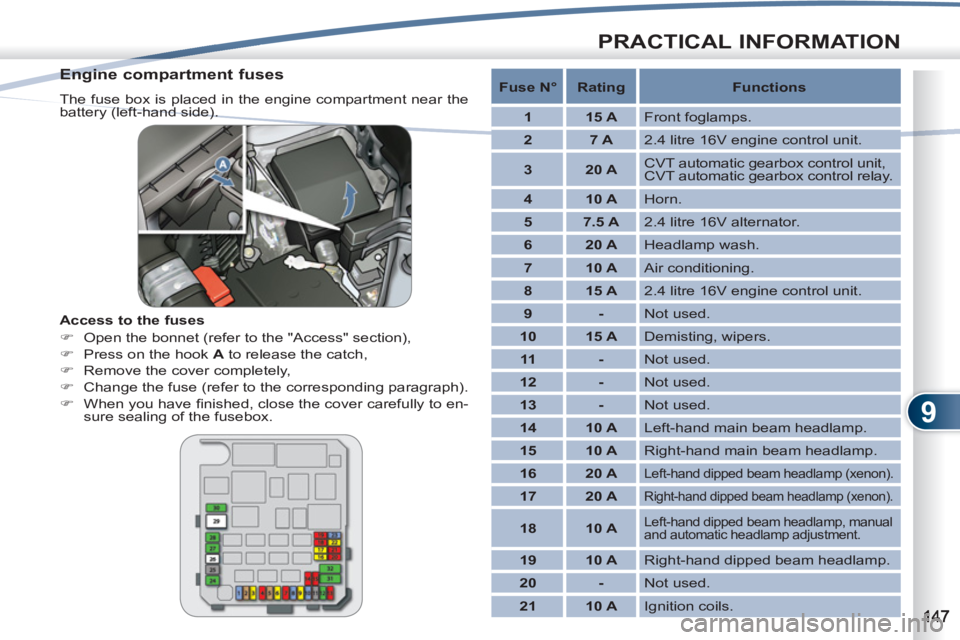
9
PRACTICAL INFORMATION
Engine compartment fuses
The fuse box is placed in the engine compartment near the
battery (left-hand side).
Access to the fuses
�)
Open the bonnet (refer to the "Access" section),
�)
Press on the hook A
to release the catch,
�)
Remove the cover completely,
�)
Change the fuse (refer to the corresponding paragraph).
�)
When you have fi nished, close the cover carefully to en-
sure sealing of the fusebox.
Fuse N°
Rating
Functions
1
15 A
Front foglamps.
2
7 A
2.4 litre 16V engine control unit.
3
20 A
CVT automatic gearbox control unit,
CVT automatic gearbox control relay.
4
10 A
Horn.
5
7.5 A
2.4 litre 16V alternator.
6
20 A
Headlamp wash.
7
10 A
Air conditioning.
8
15 A
2.4 litre 16V engine control unit.
9
-
Not used.
10
15 A
Demisting, wipers.
11
-
Not used.
12
-
Not used.
13
-
Not used.
14
10 A
Left-hand main beam headlamp.
15
10 A
Right-hand main beam headlamp.
16
20 A
Left-hand dipped beam headlamp (xenon).
17
20 A
Right-hand dipped beam headlamp (xenon).
18
10 A
Left-hand dipped beam headlamp, manual
and automatic headlamp adjustment.
19
10 A
Right-hand dipped beam headlamp.
20
-
Not used.
21
10 A
Ignition coils.
Page 152 of 236
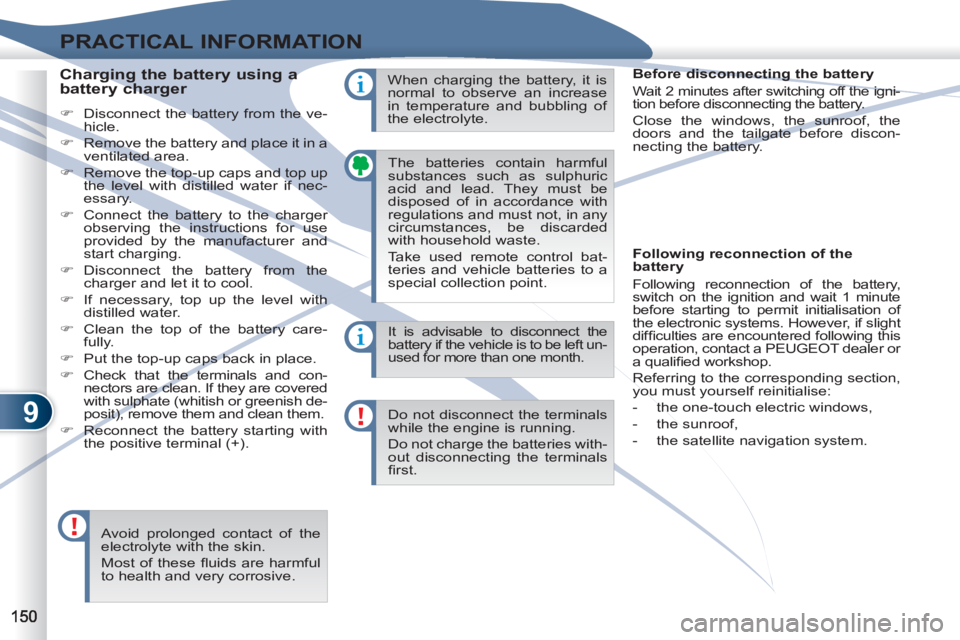
9
PRACTICAL INFORMATION
The batteries contain harmful
substances such as sulphuric
acid and lead. They must be
disposed of in accordance with
regulations and must not, in any
circumstances, be discarded
with household waste.
Take used remote control bat-
teries and vehicle batteries to a
special collection point.
Charging the battery using a
battery charger
�)
Disconnect the battery from the ve-
hicle.
�)
Remove the battery and place it in a
ventilated area.
�)
Remove the top-up caps and top up
the level with distilled water if nec-
essary.
�)
Connect the battery to the charger
observing the instructions for use
provided by the manufacturer and
start charging.
�)
Disconnect the battery from the
charger and let it to cool.
�)
If necessary, top up the level with
distilled water.
�)
Clean the top of the battery care-
fully.
�)
Put the top-up caps back in place.
�)
Check that the terminals and con-
nectors are clean. If they are covered
with sulphate (whitish or greenish de-
posit), remove them and clean them.
�)
Reconnect the battery starting with
the positive terminal (+). It is advisable to disconnect the
battery if the vehicle is to be left un-
used for more than one month.
Do not disconnect the terminals
while the engine is running.
Do not charge the batteries with-
out disconnecting the terminals
fi rst.
Avoid prolonged contact of the
electrolyte with the skin.
Most of these fl uids are harmful
to health and very corrosive. When charging the battery, it is
normal to observe an increase
in temperature and bubbling of
the electrolyte.
Before disconnecting the battery
Wait 2 minutes after switching off the igni-
tion before disconnecting the battery.
Close the windows, the sunroof, the
doors and the tailgate before discon-
necting the battery.
Following reconnection of the
battery
Following reconnection of the battery,
switch on the ignition and wait 1 minute
before starting to permit initialisation of
the electronic systems. However, if slight
diffi culties are encountered following this
operation, contact a PEUGEOT dealer or
a qualifi ed workshop.
Referring to the corresponding section,
you must yourself reinitialise:
- the one-touch electric windows,
- the sunroof,
- the satellite navigation system.
Page 153 of 236
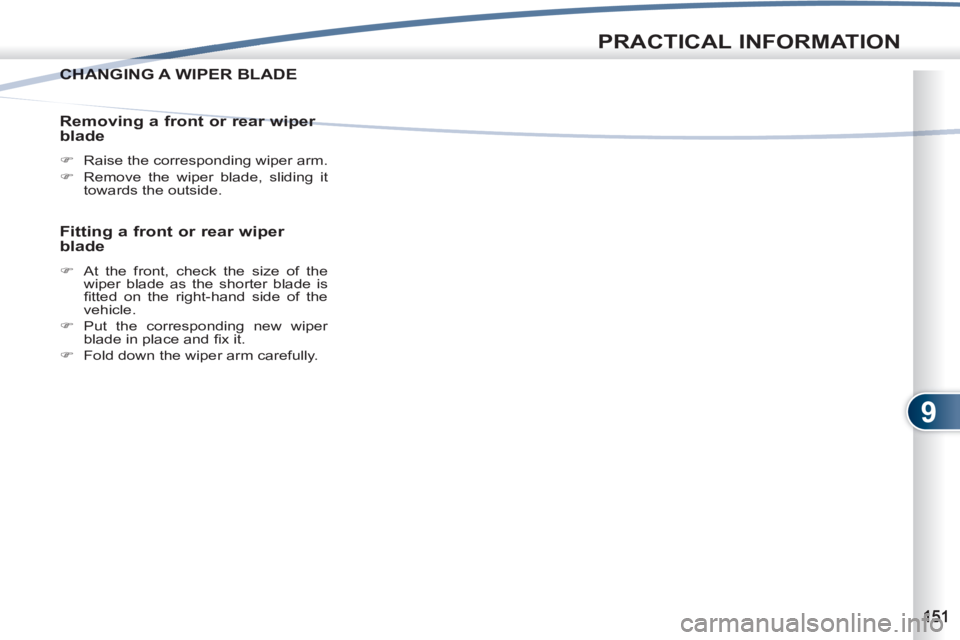
9
PRACTICAL INFORMATION
CHANGING A WIPER BLADECHANG
Removing a front or rear wiper
blade
�)
Raise the corresponding wiper arm.
�)
Remove the wiper blade, sliding it
towards the outside.
Fitting a front or rear wiper
blade
�)
At the front, check the size of the
wiper blade as the shorter blade is
fi tted on the right-hand side of the
vehicle.
�)
Put the corresponding new wiper
blade in place and fi x it.
�)
Fold down the wiper arm carefully.